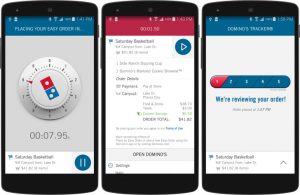 The best pizzeria in my town doesn’t have online ordering and delivery. That’s a deal breaker for me. As such, I tend to order from the not-as-good pizzeria because they do offer those conveniences.
The best pizzeria in my town doesn’t have online ordering and delivery. That’s a deal breaker for me. As such, I tend to order from the not-as-good pizzeria because they do offer those conveniences.
Technology has trained me to expect convenience in nearly all things. I watch shows on demand through Netflix, avoid big box retailers with Amazon 1-Click, and get new video games instantly through Steam. My internet connection and mobile devices have turned me into a bottomless pit of instant gratification.
In a digital world built to satisfy my daily wishes, I must sit in my truth: I’m not going out for pizza.
I may use my phone to order that pizza, but I’m certainly not talking to anyone. I’d rather get sub-par pizza straight to my door (charged to my debit card, of course) than talk to the pizza guy at the better pizzeria and take a five minute drive to pick it up (and pay with paper money!). My mobile phone tells me it’s not the convenient play. And we live in a very convenient, very mobile world these days.
Google Wants to Be Convenient
I want things to be convenient. I don’t want to wait in line, and I certainly don’t want to sift through duds. Thankfully, Google reinforces my low impact behavior with every algorithm update.
Google noticed we spend more time on our mobile devices than on our computers, so they’re going to make things more convenient for that experience. Called ‘Mobile-first Indexing,’ Google’s latest plan is to “use the mobile version of a site’s content to rank pages from that site, to understand structured data, and to show snippets from those pages in our results.” The old approach was to use the desktop version of the site to provide this context. In other words, your mobile site will determine the fate of your desktop site in Google in the coming months.
Click to Read: Google Mobile-First Index Myths
Google, of course, is doing this for pragmatic reasons. If everyone would rather use Voice Search on their phones than tap keys on a laptop to navigate the Web, why not reward sites that have the best mobile experience? This incentivizes businesses to switch to a website presentation more conducive to mobile performance. This also plays into Google’s goal of speeding up mobile browsing, which helps to explain their prioritization of Accelerated Mobile Pages (AMP).
A faster Mobile Web sounds great to me. Load that pizza order screen faster, and I’m a happy customer. This sounds like a win for everybody, right?
Personally Panned Pizza
 There are 20 pizza places in my town, which, admittedly, is a lot of pizza options for one Philadelphia suburb. To be fair, four of those options are national chains.
There are 20 pizza places in my town, which, admittedly, is a lot of pizza options for one Philadelphia suburb. To be fair, four of those options are national chains.
If I’m being generous, all but one of the local pizzerias have terrible mobile site presentations. This tells me nothing of the quality of their pizza. If I’m choosing my dinner based on which location has the best mobile site, then I’m basing my decision off of criteria that won’t get me the best slice of pepperoni. Now I’m missing out.
Convenience Is a Killer
Better mobile adoption will be more convenient in the long run, but in the short-term the losers of this exchange are likely to be local businesses – those that are great at their core service but lacking in digital marketing efforts. Local stores and service providers that are more likely to spend dollars on signage or diner placemat ad space than Web development will be hit the worst by Mobile-first indexing.
The initial beneficiaries of Mobile-first will likely be chain stores, since they are able to apply significant spend to digital marketing efforts that will benefit their multiple locations. Domino’s has already invested in a responsive design website, online ordering, a mobile app for every operating system, and a GPS Driver Tracker. They’re still at the bottom of the list come dinnertime.

Mobile-first works out great for Domino’s but not so great for independent business owners. Google is making a big ask of the little guy: spend money on a new website, or risk digital obscurity.
While that may seem like an alarmist statement, in this case the past is prologue. The 2014 Google Pigeon Update had a major impact on local businesses that could no longer compete in areas outside of their geo-radius. In 2015, the switch from a seven-pack to a three-pack for Google Local results reduced the visibility playing field for small businesses. For every algorithmic update Google rolls out, a certain amount of local businesses will be forced to close their doors.
Mobilizing Your Small Business
If you’re a small business owner – especially one that makes a great stromboli – it’s time to get your Mobile presentation right. For independent operators that are heavily focused on their margins, this may prove challenging. Several paths to being Mobile-first ready exist, and it’s in your interest to find the most cost-effective avenue.
AMP has been pushed heavily by Google, and this option ensures the fast rendering of your Mobile site. While there’s a learning curve here, small businesses may be able to react more quickly than large corporations that likely have more Web assets to transition. The official Accelerated Mobile Pages (AMP) Project website even has tutorials to help you get started.
Responsive design is a great solution for businesses looking to launch of new SEO-friendly website. Build one website that looks great on any device by using CSS and HTML to resize, hide, shrink, enlarge, or move the content.
If the needs of your Mobile audience are different than your Desktop audience, adaptive delivery may be your best bet. With adaptive delivery, the server hosting the website detects the device making the request to it, and uses this information to deliver different batches of HTML and CSS code based on the characteristics of the device that it’s detected.
These are all strong options for any website, but for a local business the decision will likely come down to the costs of finding a solid Web developer and of implementation. No matter what you select, you’re “m.” mobile subdomain and “/m/” mobile subdirectory should be retired.
A Plea to My Pizzeria
While the above advice is applicable to any business in need of a Mobile website overhaul, this message goes out to my local pizzeria first and foremost. Mobile-first indexing may present an inconvenience to you. Take it seriously, however, or you may find yourself another casualty of Google’s steady stream of algorithmic updates.
I crave convenience, and Google (partially) made me that way. Get that responsive website in place, push out your menu through AMP, and (just for me) find an online ordering vendor like FoodTec Solutions.
Get out there, and show Domino’s that your mean business. I don’t want to be condemned to a life of sub-par pizza made by really great mobile marketers.











